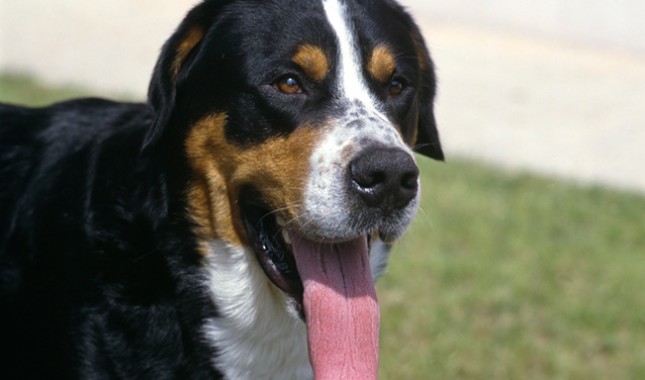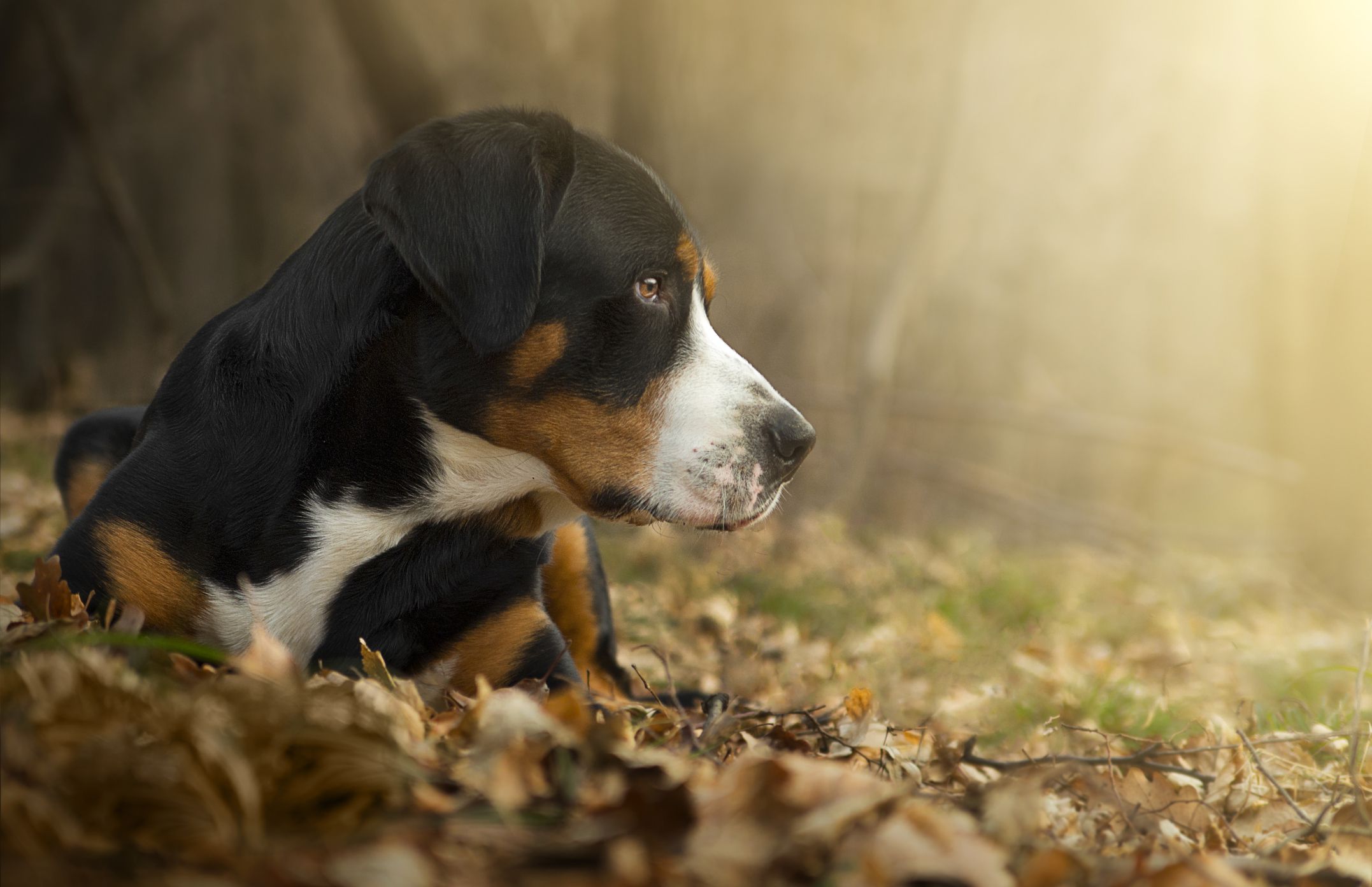The Greater Swiss Mountain Dog is a dog breed which was developed in the Swiss Alps. The name Sennenhund refers to people called Senn or Senner, dairymen and herders in the Swiss Alps. Greater Swiss Mountain Dogs are almost certainly the result of indigenous dogs mating with large mastiff types brought to Switzerland by foreign settlers. At one time, the breed was believed to have been among the most popular in Switzerland. It was assumed to have almost died out by the late 19th century, since its work was being done by other breeds or machines, but was rediscovered in the early 1900s.
The breed is large and heavy-boned with great physical strength, but is still agile enough to perform the all-purpose farm duties it was originally used for. Its breed standard calls for a black, white, and rust colored coat.
The Greater Swiss Mountain Dog is sociable, active, calm, and dignified, and loves being part of the family. It is relatively healthy for its size and tends to have far fewer problems than more popular breeds in its size range. Among the four Sennenhunde, or Swiss mountain dogs, this breed is considered the oldest, and is also the largest.
History

Breed history
The origin of the Greater Swiss Mountain Dog is not known. Beginning in 1515, the remote valleys of Switzerland were more or less isolated from world history for three centuries. Specific dog breeds were created by inbreeding, and puppies were given to neighbors and family members.
There are several theories regarding the origin of the four Sennenhund breeds. The most popular theory states the dogs are descended from the Molosser, a large Mastiff-type dog, which accompanied the Roman Legions on their invasion of the Alps more than 2000 years ago.
A second theory is that in 1100 BC, the Phoenicians brought a large dog breed with them to settlements in Spain. These dogs later migrated eastward and influenced the development of the Spanish Mastiff, Great Pyrenees, Dogue de Bordeaux, and Sennenhund breeds.
A third possibility is that a large dog breed was indigenous to central Europe during the Neolithic Period, when humans grew wild and domestic crops and used domesticated animals. Whether or not a domesticated large breed existed in the Alpine area when the Romans invaded, Greater Swiss Mountain Dogs are almost certainly the result of the mating of native farm dogs with large Mastiff-type dogs brought to Switzerland by foreign settlers. The early ancestors of the Greater Swiss Mountain Dog were used by farmers, herdsmen and merchants in central Europe. The breed was bred as a draught dog to pull heavy carts, to guard and move dairy cattle, and as a watchdog and family companion.
Appearance
The Greater Swiss Mountain Dog is a draft and drover breed, it is a large, heavy-boned dog with incredible physical strength. Despite being heavy-boned and well-muscled, the dog is agile enough to perform the all-purpose farm duties of the mountainous regions of its origin.
Coat
There is black on top of the dog’s back, ears, tail and the majority of the legs. There should be rust on the cheeks, a thumb print above the eyes, and also rust should appear on the legs between the white and black. There should be white on the muzzle, the feet, the tip of the tail, on the chest, and up from the muzzle to pass between the eyes. Symmetry in markings and coloring are not a priority in the American Kennel Club standard for the breed. Function and temperament are prioritized as the dog must work. It is common to hear the phrase “the head doesn’t pull the cart” or “markings don’t pull the cart” to mean that cosmetic features are not highly valued.
The double coat has a dense outer coat of about 1.25 to 2 in (3.2 to 5.1 cm) long. Textures of the topcoat can range from short, straight and fine to longer, wavier and coarser. The under coat is thick and ranges from the preferred dark gray to light gray to tawny, and must be on the neck, but can be all over the body – with such a thick coat, Sennenhunde shed throughout the year and they have a major shedding once or twice a year.
While the Greater Swiss Mountain Dog Standard calls for a black, white and rust dog; they do come in other colors which include blue, white and tan tri-color; and rust and white bi-color. On the blue tri-color dogs, blue replaces where black would be and tan replaces where the rust would normally be. On the rust bi-color dogs, the dog is solid rust and white markings with a total absence of black coloring.
Size
Males range between 25.5 to 28.5 in (65 to 72 cm) at the shoulder and females range between 23.5 to 27 in (60 to 69 cm) at the shoulder. There is no standard for weight in the Greater Swiss Mountain Dog; males tend to range between 90 to 135 lb (41 to 61 kg) and females range between 80 to 110 lb (36 to 50 kg). Body length to height is approximately a 10 to 9 proportion; they are slightly longer than tall.
Temperament
The Greater Swiss Mountain Dog is happy with an enthusiastic nature and strong affinity to people and children. This breed is sociable, active, calm and dignified. While the breed does need exercise, they do not need a vast space. The breed often stands close to their owners, rarely straying far away without checking in. They will not be happy confined to kennel life; they want to enjoy their family. They crave attention and physical contact. Greater Swiss Mountain Dogs are bold, faithful and willing workers and are eager to please. The Greater Swiss Mountain Dog is confident, the breed is gentle with children. They can be stubborn and determined. The Greater Swiss Mountain Dog is an intelligent breed and is a quick learner. They can be difficult to housebreak, taking up to 6 months or more.
The activity level in the Greater Swiss Mountain Dog is variable. They are capable of being athletic, but usually that activity is in bursts; they are active for short periods followed by napping. They want to be with their owners and to participate; their activity level most often matches the activity level of the family. As a working dog, they like having a job to do and enjoy participating in hiking, carting, obedience trials, herding, weight pulling and backpacking with their owners.
Being alert and vigilant, the Greater Swiss Mountain Dog is a good watchdog. They tend to notice everything in their surroundings and are quick to sound alarm. Faced with a threat, they will stand their ground and put on a show that will intimidate those unfamiliar with the dog.
Greater Swiss Mountain Dogs are accepting of a non-threatening stranger. They are confident and comfortable in unfamiliar locations, and are stable around strange noises and unfamiliar people. They are accepting of other dogs and species, and are reluctant to bite.
This giant breed matures slowly in both mind and body, taking anywhere from 2 to 3 years. The objective in training this dog is for the owner to build trust through humane methods. As youngsters, they can be quite boisterous and they do require steady and reliable training to develop manners and physical self-control. As with all large, active working dogs, this breed should be well socialized early in life with other dogs and people, and be provided with regular activity and training.
